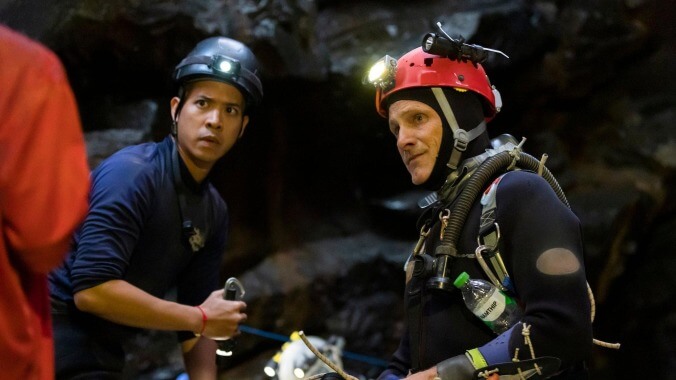Ron Howard's Thirteen Lives has plenty of heroes but not enough depth
Colin Farrell and Viggo Mortensen star in this retelling of the courageous real-life rescue of a stranded Thai soccer team

Jimmy Chin and Elizabeth Chai Vasarhelyi’s recent documentary The Rescue chronicled a not-too-distant event that captured the world’s attention and united strangers: the 2018 mission to save a youth soccer team trapped inside a flooded cave in Thailand. It did so with escalating drama, white-knuckle tension and inspirational uplift, successfully dodging the cliché of being “too soon.” Director Ron Howard’s Thirteen Lives, a fictionalized account of the same saga, cannot escape the shadow of that documentary, nor its thoroughly documented subject. Taking a journalistic approach that’s similar to its predecessor, Howard’s film winds up as a rote retread, transitioning from headline news to big-screen snooze.
June 23 begins as an average day for the young kids and the coach of the Wild Boars, having fun, playing soccer in the summer sun. To celebrate Prem’s (Achi Jinapanyo) birthday, the Boars take a spontaneous field trip to explore the Tham Luang cave network, just as torrential rains flood the miles-long system. Outside, parents call the Thai authorities, but it quickly becomes clear that the impending rescue effort is going to take a miracle.
Everyone from the determined governor (Sahajak Boonthanakit) to quick-acting Thai Navy SEALs scramble to form a logistical plan to bring the boys to safety. A few highly experienced British cave divers and an Aussie anesthesiologist also show up to help: Rick (Viggo Mortensen), John (Colin Farrell), Chris (Tom Bateman) and Harry (Joel Edgerton) contribute a high level of expertise that proves invaluable to the delicate operation, even as their resources begin to dwindle. Making matters worse, monsoon season arrives early, prompting water engineer Thanet (Nophand “Aon” Boonyai) and his fleet of volunteers to innovate new methods to divert incoming water and prevent further flooding.
This film is at its best with the underwater scenes, where Howard’s cave-diving footage puts the audience into claustrophobic, muddy-water environments. These submerged sequences skillfully convey the dangerous external stakes faced by the protagonists. By shooting scenes in the first-person perspective, the camera becomes our avatar. The divers’ fear of the unknown is our fear of what’s lurking beyond the frame. Simon Christidis’ underwater cinematography is complimented by James Wilcox’s finely tuned edits and Benjamin Wallfisch’s percolating score, which shape the narrative with generous nuance. Production designer Molly Hughes’ work recreating the caverns and tunnels, where rigid stalactites and stalagmites act as a prison, externalizes the divers’ disorienting headspace.
Yet it’s more than a little frustrating that, in a movie that runs almost two and half hours, Howard and screenwriter William Nicholson (working from a story by Don MacPherson) fail to deliver properly developed characters. Feeling both rushed and inert, the narrative doesn’t have much interest in delving into the fascinating and complex lives of these real-life heroes. Conflicts remain superficial, when these characters’ trials and tribulations could illuminate their psyches, not to mention the rescue effort’s stakes.
Sidestepping survival-story formulas adds some value, but the filmmakers unnecessarily manufacture creative license elsewhere, which disrupts both tension and a purported aim for authenticity. Though the film decentralizes the white cave divers better than The Rescue did, showcasing a more comprehensive effort of Thai heroism, bravery and sacrifice, it doesn’t give these characters the resounding, earned Movie Moments they deserve, nor does it give those actors well-rounded characters. Moreover, not many are given as much grace as the film’s movie stars; they’re comparatively two-dimensional—exemplified by heroic Thai Navy SEAL Saman (Sukollawat Kanarot), whose background in the film lacks the depth his real counterpart deserves.
Considering this film comes from a man who made fire sound like a frightening, monstrous beast in Backdraft, translated child-rearing into a visceral experience in Parenthood, and captured the electric anxiety of disseminating the news in The Paper, Thirteen Lives suggests that Howard’s intentions, at least these days, are stronger than his creative vigor. Instead of being enveloped by the innate emotional power of this real-life tale, we’re held at arm’s length, invited to exercise little more than base empathy. For such an extraordinary event, Howard’s depiction feels disappointingly routine.